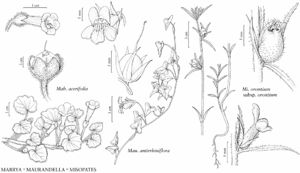Maurandella
Feddes Repert. Spec. Nov. Regni Veg. 52: 26. 1943.
| Taxon | Illustrator ⠉ | |
|---|---|---|
 | Mabrya acerifolia Maurandella antirrhiniflora Misopates orontium subsp. orontium | Barbara Alongi Barbara Alongi Barbara Alongi |
Herbs, perennial; caudex woody. Stems climbing, glabrous. Leaves cauline, alternate; petiole twining; blade fleshy, not leathery, margins entire. Inflorescences axillary, flowers solitary; bracts absent. Pedicels present; bracteoles absent. Flowers bisexual; sepals 5, distinct, lanceolate, calyx bilaterally symmetric, campanulate; corolla blue to violet, pink, or red, bilaterally symmetric, bilabiate and personate, tubular, tube base not spurred or gibbous, lobes 5, abaxial 3, adaxial 2; stamens 4, basally adnate to corolla, didynamous, filaments glandular-hairy; staminode 1, filamentous; ovary 2-locular, placentation axile; stigma 2-lobed. Fruits capsules, dehiscence loculicidal. Seeds 80–150, dark-brown to black, ovoid to oblong-polygonal, wings absent. x = 12.
Distribution
sw, sc United States, Mexico
Discussion
Species 2 (1 in the flora).
Maurandella most commonly has been recognized as a genus segregated from Maurandya Ortega or as a section within Maurandya, based on distinctive characteristics: personate corolla, globular capsule, V-shaped septum, and marked asymmetry of the locules. The V-shaped septum results in unequal locule volumes, which is unique in Antirrhineae. Based on this unique combination of characteristics, Maurandella is recognized here as a genus distinct from Epixiphium and Maurandya.
Initial molecular phylogenetic studies indicated a sister group relationship between species of Maurandella and Maurandya (M. Ghebrehiwet et al. 2000); they lacked the taxon sampling needed to resolve relationships among closely related species in Epixiphium, Maurandella, and Maurandya (C. E. Freeman and R. Scogin 1999; P. Vargas et al. 2004). The more complete ITS sampling by M. Fernández-Mazuecos et al. (2013) placed both genera in the Cymbalaria clade, but not as sister taxa; Maurandya was sister to Lophospermum, whereas Maurandella was nested in a more basal position within a seven-taxon subclade comprising genera in subtribe Maurandyinae.
Maurandella hederifolia Rothmaler is known from northern Mexico.
Selected References
None.